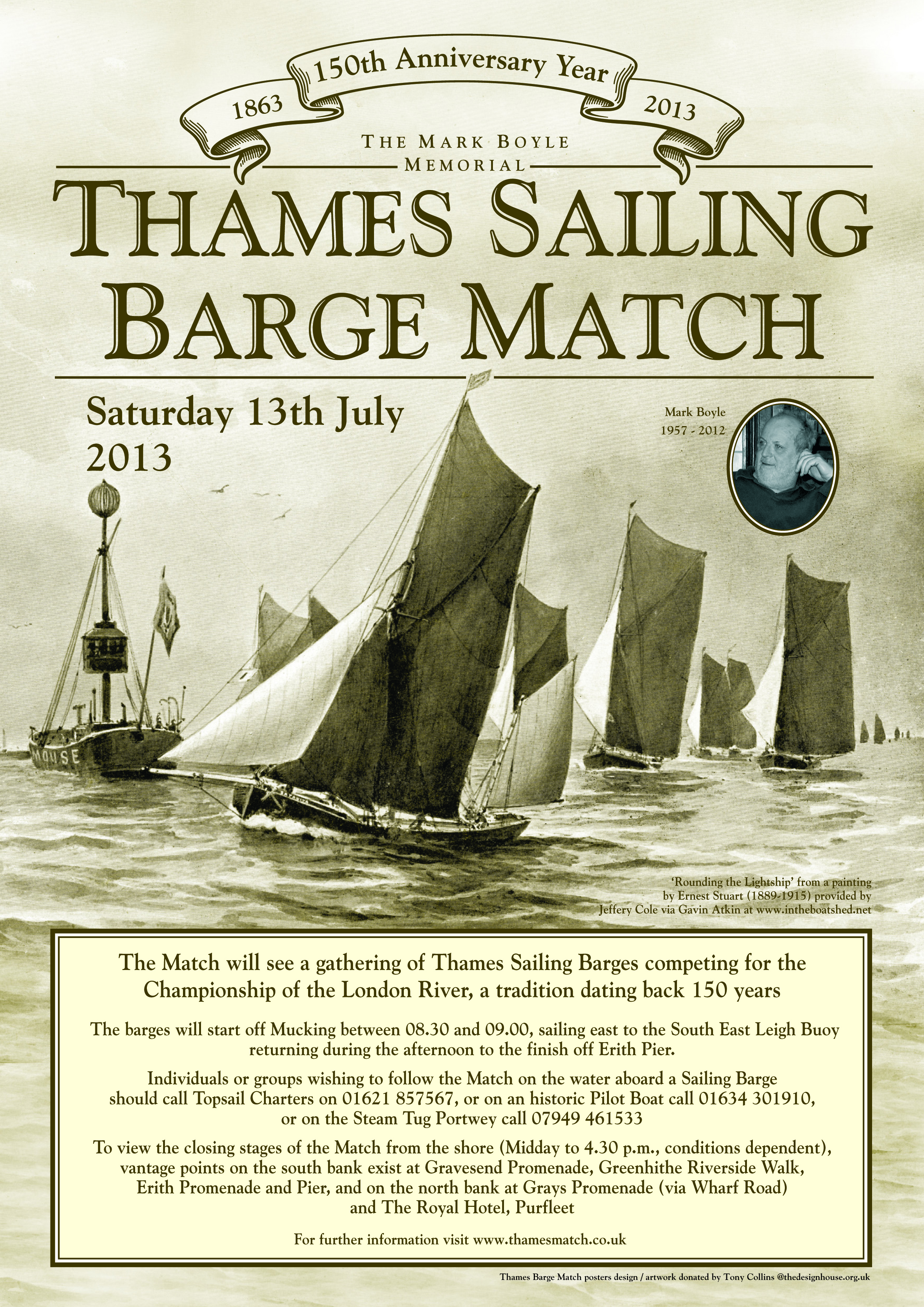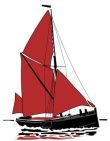The year 2013 saw the 150th anniversary of the Thames Sailing Barge Match and a record number of craft gathered to celebrate the occasion. It had been the intention of the late Match Secretary, Mark Boyle, that the original 1863 course finishing at Erith should be sailed and with the co-operation of the Port of London Authority we were able to realise that wish.
Sixteen competitors and two following barges came to the line on Saturday, 13 August, to find conditions flat calm at 0830 for the start of the Coasting class. First away was the diminutive Lady of the Lea, followed by Centaur, Lady Daphne, Cambria and Reminder. Ardwina had to use her engine to avoid drifting the wrong side of the start mark and took a time penalty. Wyvenhoe did the same in the staysail class leaving their first start to be made by the newly re-rigged Niagara a mere half minute after the 0845 gun. She was followed by Repertor and Edith May, the latter managing to set two topmast staysails (there are no sail restrictions in the Thames Match). In the Bowsprit class Decima had to anchor but dragged over the start line before the gun in the strong ebb tide, May and Xylonite drifted across together early and Marjorie was just half a length over when the gun went at 0900. The engineless barges Mirosa and Edme were more cautious and Mirosa made a good start one minute after the gun.
The barges all drifted downstream, those on the Essex end of the line including Ardwina, Edith May, Centaur, Wyvenhoe, Lady Daphne and Xylonite had a stronger tide, but were set into the bight and had to anchor above the new London Gateway port development. Those who had started on the Kent shore had less tide, but drifted clear down the edge of the Blyth sand and came through with an advantage, Lady of the Lea leading the field as the lightest of airs came in from the south. The Mid Blyth Buoy, barely six miles from the start, was chosen as the turning mark in the fickle conditions and Lady of the Lea reached it at 1030, two hours after her start. She was followed by Cambria which nicely judged the approach from her mid-channel course. Edme had worked her way through the rest of the fleet to reach the Mid Blyth at 1044. Although the barges could not make real headway back upstream against the last of the ebb none resorted to their anchors, perhaps having seen signs of a providential breeze approaching from seaward. Xylonite and Mirosa were neck-and-neck at the mark, both rounding well, with Mirosa on the inside. The change of direction to an easterly breeze coupled with the start of the flood tide then made rounding more difficult and the tail-enders were eventually excused what had become impossible in order to finish the Match the same day!
Running back up the river the barges broke out whatever light weather sails they could find – Cambria a yacht spinnaker, Decima an unorthodox stemhead staysail in addition to the bowsprit jib, and even the traditionalist Mirosa finding a rather yachty-looking striped flying jib. Cambria found the edge of the Blyth sand and stopped for a while and Centaur promptly joined her. The rest of the fleet made steady progress upstream in a breeze which occasionally reached force 2 giving good steerage way and scope for duels between barges to add interest. Commercial traffic on the river was greater than in recent matches and a large container ship coming down from Tilbury dwarfed the barges running up Gravesend Reach and provided a contrast between the centuries for spectators.
Edme was first to cross the finish line at Erith at 1448, in a time of 5 hours 48 minutes, watched by a good crowd which had assembled on the shore and on the restored Erith Deep Wharf, now a public amenity. She was closely followed by Xylonite, Cambria winning the Coasting class, Niagara winning the Staysail class at 1500 with Mirosa, Lady of the Lea and May so closely following as to tax the gunners to reload and fire sufficiently quickly. The remaining barges all finished under sail with Centaur bringing up the rear at 1627. The barges brought up at anchor or on buoys around the Erith waterfront providing a sight such as can hardly have been seen there within living memory and which was eventually enhanced by a colourful sunset.
The Prize-giving was hosted by the Erith Yacht Club and prizes were presented by Sir Robin Knox-Johnston who entertained the assembled company with reminiscences of Derek ‘Spiro’ Ling, the former skipper of Lady Daphne who died last year. In addition to the place prizes, the award for seamanship was made to ‘Mac’ McCalden, Master of Lady of the Lea, whose performance throughout the Match had been exceptional. The Gold Belt trophy for achievement was awarded for the restoration of Niagara.
Although the sailing conditions were not as challenging as one might like, the Match was safely and successfully accomplished and, whether or not it concludes this series of races, stands as a fitting tribute to the memory of Mark Boyle, so much of whose time and effort was invested in its revival.
Julian Cass
Officer of the Day
2013 results
A Supper for the Owners, Crews, Organisers and Guests, followed by the prize-giving, took place at the Erith Yacht Club on Saturday, 13 July.
Prizes were presented by Sir Robin Knox-Johnston CBE, RD, first man to circumnavigate the globe under sail, single-handed and non-stop, in 1968 aboard his 32 foot Suhaili, and the oldest solo circumnavigator when he did it aged 68 in 2007.
He is a past President of the Sail Training Association, was a Trustee of the National Maritime Museum at Greenwich, and remains a Trustee of the National Maritime Museum – Cornwall, where Suhaili is an exhibit. He is also a past President of the Cruising Association and remains that organisation’s Patron. Through his Clipper Ventures organisation and the Clipper Round the World Yacht Race he has introduced hundreds of people to competitive sailing, a pastime enjoyed as much by barge crews in the Thames Barge Match as those aboard his Clipper fleet in the Southern Ocean.
Other Links:
Match Poster:
This year’s special poster departs somewhat from the style adopted over recent years, insofar as it features the renaming of the Match in tribute to the late Match Secretary, Capt Mark Boyle, whose portrait photograph is included, a ribbon to highlight the fact that it is being raced on the 150th Anniversary of the first Match in 1863 and, for the first time since this series of Matches began in 1995, a drawing depicting the race in times gone by, rather than a photograph of last year’s winner. It is hoped that this may become a valued memento of this year’s Match.
The poster illustration is from a Mezzotint from an original watercolour by the artist Ernest Stuart (1889 – 1915) who in his very short life achieved modest fame, his art enthusiastically sought after today.

